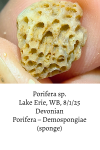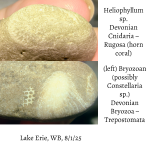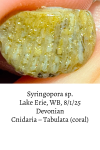Sponge
This fossil represents the preserved remains of an ancient sponge, a simple marine organism that once thrived in the shallow seas covering what is now Northwest Pennsylvania and Northeast Ohio during the Paleozoic era. Sponges from this region are often found in Silurian and Devonian rock formations, typically embedded in limestone or shale.
These fossils are characterized by their porous, often cylindrical or globular structure, with visible canal systems or a honeycomb-like texture where water once flowed through the organism. Though they may appear unassuming at first glance, sponge fossils offer a fascinating glimpse into early marine life and the long geological history of the area.
The specimen’s surface may show signs of mineral replacement, commonly calcite or silica, giving it a sturdy feel and sometimes a slight sparkle under light. Its color can range from off-white and tan to brown or gray, depending on the mineral content of the surrounding rock.
Finding a sponge fossil in this region is a reminder that the quiet hills and riverbeds of today were once teeming with marine life in a prehistoric ocean that shaped the land we know now.


